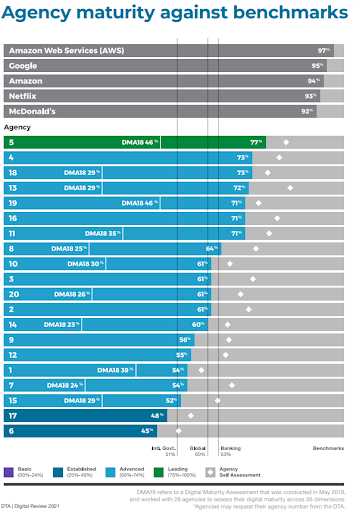
The Digital Review
The Digital Transformation Agency’s Digital was released a couple of months ago. Its goal was to assess digital maturity and capability in the Australian Public Service (APS). It’s a comprehensive report at 164 pages.
The review was originally commissioned in response to a recommendation in the Our Public Service, Our Future, Independent Review of the Australian Public led by David Thodey AO. The review also represents the government’s broader commitment to digital.
The review ‘only’ surveyed 20 Federal Government agencies, however the agencies make up 80% of government expenditure and so represent a large proportion of ICT spend.
The five pillars
Assessments, findings and recommendations are tied to five pillars:
- Alliances
- People
- Policy
- Process
- Tech and data
High level findings across these areas are:
- Alliances — Most alliances are with ICT providers and other Commonwealth agencies.
- People — There’s currently a significant reliance on external contractors/vendors for ICT talent.
- Policy — Policies support whole-of-government approaches but departments report a lack of funding to support the programs.
- Process — For agencies that are smaller, funding focuses on BAU rather than digital transformation projects.
- Tech and data — Agencies reported having the core systems they need. In terms of data sharing, a lack of governance and data catalogues/registries is limiting data sharing. There is no common definition of shared services.
Agency maturity
The diagram below (from page 30 of the report) shows the agencies’ maturities against benchmarks such as Amazon and Netflix.
Reprinted under Creative Commons Attribution 4.0 international , © Commonwealth of Australia, Digital Transformation Agency, DIGITAL REVIEW 2021
Not surprisingly, some agencies are more mature in their digital journey than others. The agencies are de-identified, but we can see from the above chart that the range of maturity is large, from 45% (which is ranked as ‘established’) to 77% (which is ranked as ‘leading’).
Key findings
The report highlighted 15 key findings:
- “Insufficient sustainment and business-as-usual (BAU) funding and ineffective planning and forecasting in project delivery.
- Limited visibility of investment implementation, quality, and outcomes.
- Realising increased levels of whole-of-government reuse for digital and ICT capabilities will depend on agreeing common frameworks and approaches, as well as increasing understanding and buy-in on the key enablers and benefits of reuse.
- Existing policy settings are frustrating agency efforts to achieve the flexibility and agility they require to deploy their workforces most efficiently and effectively in pursuit of digital transformation.
- Agencies do not consistently measure and benchmark the quality of their services and functions, and currently overestimate the quality of services they are providing.
- No whole-of-government digital and ICT investment plan or framework.
- Ineffective data management and sharing.
- Cloud adoption is complex and often considered risky.
- Cyber security compliance considered ineffective.
- Digital Service Standard adoption needs to be strengthened to ensure new ways of working are consistently deployed to create world-class services.
- Lack of whole-of-government coordination of essential policies and standards for digital and ICT capability, including in relation to cyber security.
- Barriers to agility in delivery and budgeting.
- APS workforce digital and ICT capability not prioritised.
- Limited understanding of workforce.
- Disjointed workforce planning is hampering efforts to achieve and sustain a workforce ready to harness digital technology and new ways of working for the betterment of digital services.”
Recommendations to focus on
The report identified 24 recommendations across the five pillars. Of these recommendations, 8 were identified as areas the DTA believes need additional attention and/or are not being addressed through existing work.
The 8 key recommendations are:
- “People: Ensure SES leaders are able to lead and embed transformational change in support of the government’s digital aspirations for 2025 and beyond.
- Policy: Investigate whole-of-government approaches to developing and effectively maintaining a comprehensive model digital policy suite and associated digital policy lifecycle management approach for agencies.
- Policy: Identify and address structural barriers to collaboration across agency digital functions and digital and ICT projects and programs.
- Policy: Seek to address ongoing funding challenges associated with digital and ICT across whole-of-government, initially by developing an alternative sustainable funding framework spanning the full lifecycle of digital development and delivery which ensures digital products are continuously improved, meet increasing expectations and do not create technical debt.
- Process: Strengthen guidance for agencies on agile financial management to increase uptake of agile approaches to project, product, and sustainment.
- Process: Develop and mandate a whole-of-government digital and ICT initiative benefits realisation, outcome tracking, and implementation oversight framework to ensure initiatives deliver expected results.
- Process: Develop guidance to support agencies in aligning to common reporting standards for covering key dimensions including risks and benefits.
- Tech and data: Undertake analysis of effective benchmarking approaches in government service quality, performance, and stakeholder satisfaction to inform future implementation and enable continuous improvement.”
You can read all the recommendations in the full .
Salsa Digital’s take
The Digital Review echoes many of the themes and opportunities we see in government. It also ties into many areas of Salsa’s work and to our mission: to deliver a more open, more connected and more consolidated government.
We have strong alliances with government and see the power of these alliances on a daily basis. Strong partnerships can improve government services and ultimately deliver better services to citizens. We’re also whole-of-government advocates and are involved in several whole-of-government programs including GovCMS, Victoria’s Single Digital Presence, NSW, WA, and many state open data initiatives. We also work proactively to bring jurisdictions together so Australia can benefit from shared services and platforms, removing unnecessary duplication.

